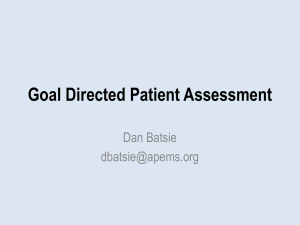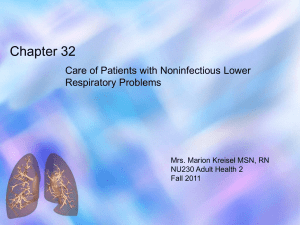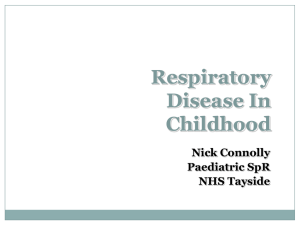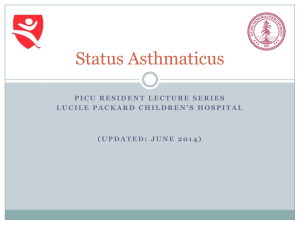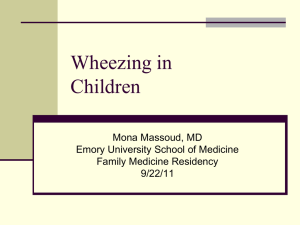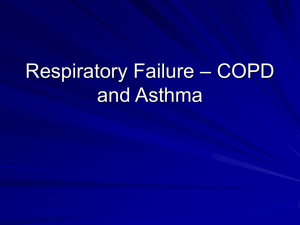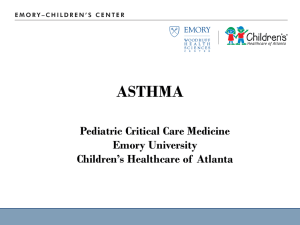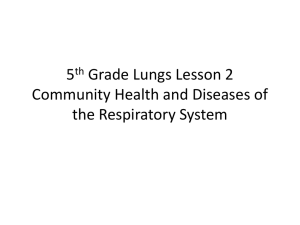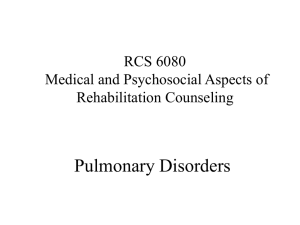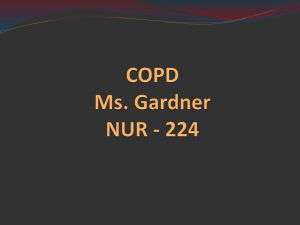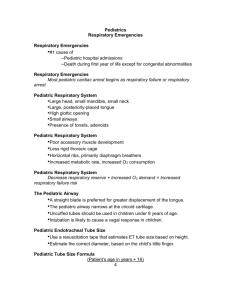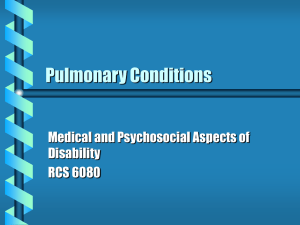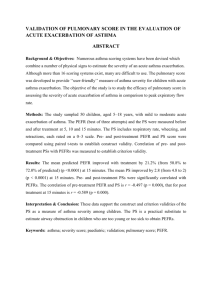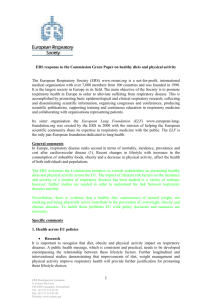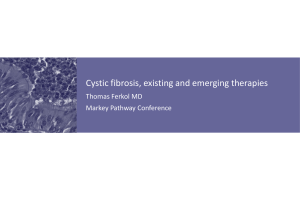Asthma and Cystic Fibrosis
advertisement
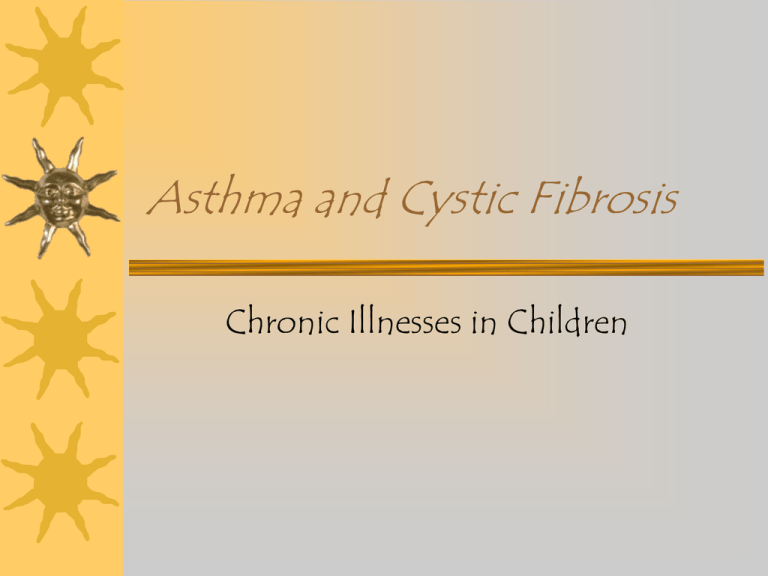
Asthma and Cystic Fibrosis Chronic Illnesses in Children ASTHMA Why study Asthma? – The most common chronic disease of childhood – The primary cause of school absences – Is responsible for a major proportion of pediatric admissions to emergency departments and hospitals – Healthcare alone for asthma cost the nation $6.2 billion in 1990, with hospitalization accounting for about $1.6 billion of that figure. Prevalence has increased by 29% in last decade. – CDC Statistics re: current amounts – Nearly 5,000 Americans die each year from asthma Definition A diffuse, pulmonary disease characterized by 1.)Airway inflammation 2.)Airway hyperreactivity manifested by difficulty breathing resulting from generalized narrowing of the airways. Triggers tending to precipitate &/or aggravate asthmatic exacerbations. Allergens-- Outdoors: trees, shrubs, weeds, grasses, molds, pollens, air pollution, spores Indoors: dust &/or mites,mold, cockroach antigen Irritants– tobacco smoke, wood smoke, odors, sprays Exposure to occupational chemicals Exercise Cold air Changes in weather or temperature Colds & infections Environmental change: moving to new home, starting new school, etc. Animals: cats, dogs, rodents, horses Medications: ASA, NSAID’s, Antibiotics, beta blockers Strong emotions: fear, anger, laughing, crying Conditions: GE reflux, TEF Food additives: sulfite preservatives Foods: nuts, milk/dairy products Endocrine factors: menses, pregnancy, thyroid disease Asthma Severity Classification in Children 0-11 yrs (Nat’l Asthma Education & Prevention Program) Severe Persistent Moderate Persistent Mild Persistent Intermittent (see Box 32-16, p. 1264 in Hockenberry, 9th ed, 2011) Steps in progression of Asthma-See Fig. 32-9 and 32-10 pp.1266-7; 9th ed. Hockenberry. First, stimuli activate the release of inflammatory mediators from mast cells, macrophages, eosinophils, & other inflammatory cells within the airways. Next, inflammatory mediators signal other inflammatory cells to migrate into the airways and to become activated. This leads to epithelial injury, increased smooth muscle contraction & mucus secretion, swelling, & changes in the parasympathetic control of airway function. Steps in progression of Asthma(cont’d) Airways become more narrowed & obstructed. Inflammatory processes lead to airway hyperresponsiveness. Airway obstruction or narrowing causes the sx of coughing, wheezing, chest tightness, shortness of breath, & decreased endurance. Can be abrupt in onset or gradual. Major Symptoms & Associated Features Major Symptoms *Wheezing- especially on expiration *Tachypnea *Cough- harsh, often non-productive *Retractions-sub or intracostal, suprasternal, or supraclavicular *Use of accessory muscles *Gas-trapping dyspnea *Respiratory Acidosis r/t retention of CO2 & over inflation of lungs Associated Features *Rhinitis *Hx of Bronchitis * Eczema * Increased AP diameter * Elevated shoulders *Cyanosis * Assuming “tripod” position to maximize oxygenation *See “Interpreting Peak Expiratory Flow Rates “ p1336 Diagnostic Testing Hx & physical findings Pulmonary Function Tests (PFT): lots of different ones. *PEFR: greatest flow velocity during a one second forced expiration. KNOW significance of Red, Yellow, & Green Zones Skin testing: scratch skin to detect allergenicity Provocative testing: inhalation of allergen to detect allergenicity RAST(Radioallergosorbant) Test: blood test that detects seasonal or environmental allergies Blood tests: CBC may help determine etiology of Asthma exacerbation by detecting infectious process, or Eosinophelia Chest x-ray Treatment: Goal is to PREVENT ASTHMA ATTACKS Allergen control in the home & environment Chest physiotherapy: breathing exercises, physical training, & inhalation therapy to make breathing more efficient Hyposensitization: “Allergy Shots” to create an acquired immunity by desensitization. Exercise: important to maximize lung function. May need to be medicated pre-exercise to facilitate success. Swimming or musical instruments that require breathing are all good. Medications Status Asthmaticus Considered a medical emergency that can result in respiratory failure and death if untreated. Humidified O2 is administered via NC, hood, or mask to keep SaO2 > 90% If no PEFR obtainable, give epinephrine subq 0.01ml/kg/dose of 1:1000 epinephrine with a maximum dose of 0.3ml If PEFR obtainable, give 3 tx of beta-2 agonists( Albuterol 0.15mg/kg/dose)neb tx spaced 20-30 min. apart Systemic corticosteroids are also administered IV– SoluMedrol 1mg/kg/dose q 6hr is often recommended initially. Status Asthmaticus (Cont’d) Theophylline/Aminophylline is avoided in ER IV fluids are given to rehydrate at maintenance rates to avoid pulmonary edema. Antibiotics are administered for bacterial infections or to prevent 2ndary infections with corticosteroid use. Therapy is directed toward correction of dehydration, & respiratory acidosis, electrolyte disturbance, improvement of ventilation, & tx of any concurrent infection. Anti-inflammatory Meds Corticosteroids (See Handout "B") – Methylprednisolone (SoluMedrol) IV – Pediapred/Orapred/Prednisone.) PO – Budesonide Inhaler (Pulmicort turbulaler) • • • • • Action Dose Side effects Principles of use Inhaled Corticosteroids (ICS) are the tx of choice for longterm management~ less systemic side effects Cromolyn Sodium (Intal) / Nedocromil —no longer recommended. Bronchodilators Sympathomimetic – Epinephrine • Dose—0.01ml/kg of 1:1000 solution with a maximum dose of 0.3ml • Use—only in emergencies • Side effects—tachycardia, palpitations Bronchodilators (cont’d) Beta-adrenergic agonists – – – – Albuterol (Ventolin, Proventil) Levalbuterol (Xopenex) Metaproterenol (Alupent, Metaprel) Terbutaline (Brethine) • • • • Routes of administration Action Side effects Used for Exercise-induced bronchospasm (EIB) MDI—metered-dose-inhaler with spacer •Children will often be encouraged to use a spacer to increase the effectiveness of the inhaler. •Patient video on MDI Methylxanthines Primarily, Theophylline – Now used as a 3rd line of defense – Weaker bronchodilator • Can be given IV, IM, PO, PR – Potential for serious side effects if outside of therapeutic serum levels: 5-15mcg/ml. – Theophylline toxicity: >20mcg/ml • Nausea, tachycardia, irritability, distractibility, hypotension Anticholinergics Oldest form of bronchodilator – – – – Action Used for relief of acute bronchospasm Atropine and ipratropium (most common) Website with info on Atrovent inhaler Leukotriene Modifiers Block the potent inflammatory mediators called leukotrienes – Montelukast (Singulair)~ ok for children 6yrs and > – Zafirlukast (Accolate)~ only one safe in pregnancy – Zileuton (Zyflo) All these are given PO once/day, may be used as an alternative to low-dose ICS for mild persistent asthma or an addition to ICS for moderate persistent asthma NOT for treatment of acute exacerbation of asthma. Heliox Used rarely When children don’t respond to other treatment and there is difficulty with ventilation, a combination of Helium and Oxygen may be used CO2 diffuses more readily in Helium Administered through a non-rebreathing face mask See Nursing Care Plan Hockenberry, 9th ed.( pp.1274-1276) (case study) Good review of primary Nursing Diagnoses, Pt. goals, and interventions Website with patient-friendly info on asthma, also available in Spanish. National Heart, Lung, and Blood Institute of the NIH website Asthma Action Plan from the American Lung Association is a teaching tool for patients and providers. Cystic Fibrosis Definition A disease transmitted by an autosomal recessive trait whose affected gene leads to EXOCRINE GLAND DYSFUNCTION. Exocrine glands are mucus-secreting glands, so this disease affects any organ that has any exocrine glands 75% of all mutations are the F508 alteration, but there are >1000 different mutations that make the symptoms and severity unique for each individual Etiology ~25,000 affected individuals in US Median life expectancy is 33 years (range= 0-70) Autosomal recessive trait therefore, both parents must carry the gene, but may not be affected by the disease. – Risk of transmission: 1 in 4 of passing on disease, 50% will carry trait, 25% unaffected. The defective gene was discovered only in 1989 on the long arm of the chromosome 7, along with its protein product, cystic fibrosis transmembrane regulator (CFTR) Pathology CFTR (the abnormal protein in CF) found in the exocrine glands, causes increased viscosity of mucous gland secretions, causing mechanical obstruction in the – – – – – Lungs Pancreas Intestines Bile ducts Genital tracts Pathology (cont’d) Loss of Sodium and Chloride in excess amounts through perspiration (sweat glands), puts person at risk for electrolyte imbalance especially in the summer with increased perspiration. Symptoms R/T pathophysiology Pancreatic duct obstruction – Blockage impedes enzymes: • Lipase, trypsin, amylase – Enzymes don’t reach duodenum, thus impairing digestion and absorption of fats, proteins, and fatsoluble vitamins. – Symptoms include: • Steatorrhea • Azotorrhea • Bulky, foul-smelling, frothy stools, 2-3 times the normal amount • Excessive flatus *Respiratory Obstruction Upper respiratory tract – Nasal polyps, chronic sinusitis Lower respiratory tract – Thick, sticky mucus with reduced mucus clearance→ • Early airway inflammation→ • Recurrent bacterial infections and colonization with bacterial pathogens→ • Airway obstruction with air trapping and reduced elasticity→ barrel-chest, clubbing of fingers & toes • Bronchiectasis with lung destruction Complications in the respiratory tract Pansinusitis Resistant pulmonary infections~ e.g. Pseudomonas aeruginosa~common cause of pneumonia ( website ) Allergic Bronchopulmonary Aspergillosis (ABPA) Hemoptysis Pneumothorax Pulmonary HTN leading to cor pulmonale Bile duct obstruction May cause biliary cirrhosis of the liver Portal hypertension Focal biliary fibrosis Hypoprothrombinemia Prevalence increases with age Intestinal obstruction Meconium ileus—seen on newborns if no stool passed for 24-48 hrs after birth Prolonged neonatal jaundice Poor absorption →failure to thrive, slowed weight gain Distal intestinal obstructive syndrome Rectal prolapse Complications of the GI tract Intussusception Cholecystitis/cholelithiasis Pancreatitis Glucose intolerance & CF related diabetes (30%) – Non-ketotic, hypoinsulinemic (not like type 1 or 2) – Insidious onset…slow decline in insulin secretion – Prevalence increases with age. Genital tract obstruction Azoospermia in 98% of mailes – Congenital bilateral absence of vas deferens – Abnormal development of vas deferens Higher incidence of hydrocele and inguinal hernia Increase in female infertility – – – – Thickened cervical & vaginal secretions Irregular ovulation from chronic illness/poor nutrition Delayed puberty in both genders Probably due to chronic lung disease and decreased nutritional status (lower body fat composition) Other clinical manifestations Abnormality in sweat composition – Hyponatremia – Easily provoked dehydration – Heat stroke CF arthralgias and arthritis Diagnosis 70% are diagnosed by age 1 year, however there are still a fair number diagnosed later in childhood or adulthood. “Gold Standard” for diagnosis: – Sweat Test —also known as pilocarpine test. It measures for abnormal chloride content in sweat secretions. – Normal level= <40mEq/L CF level->60mEq/L Diagnosis (cont’d) Other methods – Genotyping of individual (blood or buccal smear) – Prenatal genotyping (offered to all pregnant couples by law) to detect gene F508 Absence of pancreatic enzymes—amylase, trypsin, and lipase – Stool analysis reveals high fat stools Newborn screening – Tests for elevated trypsinogen in immediate postnatal period. Not diagnostic—must be confirmed by one of the other methods Current Management Health maintenance – Quarterly visits to care center – Interdisciplinary team care • MD—directs medical management & guides team • Respiratory care—PFT’s, airway clearance, chest physiotherapy • Nutrition—goal of normal growth across lifespan • Social work—family coping, insurance, disability • Nursing—daily management, interface with school – Surveillance for complications: i.e.annual CBC, glucose chemistry, liver function, & quarterly sputum cultures Current Management Health maintenance: changes in past 10 yrs – Increased focus on nutrition—increasing evidence for association between nutritional status and lung health. – Improvement in pancreatic enzyme replacement – Early recognition and treatment of exacerbations – Participation in clinical trials using a new drug, Kalydeco, an oral med with great promise Current Management Diet: high protein, high calorie diet, lower fat foods, salt supplements in hot weather, water-soluble forms of fat-soluble vitamins A,D, E, and K given daily – Usually have 3 meals + 3 snacks/day – Some children have g-button and get hooked up to supplemental feedings from 1900-0700 to increase caloric intake. Current Management Pancreatic enzyme replacement is essential – Take with meals and snacks – Capsules can be taken whole or sprinkled on food, but cannot be chewed or crushed as they are enteric-coated enzymes that must get to the duodenum to be effective – # of capsules depends on amount of food intake. Current Management--video Respiratory Therapy – Chest physiotherapy (CPT)—is done on a daily basis BID by parents when child is healthy, QID by RT when hospitalized • Schedule in AM upon waking, mid-morning, midafternoon, and at hs. Try to avoid meal time • Vest System: review by Aetna Ins • Case study demonstrating Pulmozyme neb tx and “airway clearance therapy” with vest in cystic fibrosis. Current Management Nebulizer treatments & other inhaled meds – Recombinant human deoxyribonuclease known generically as dornase alpha or Pulmozyme, actually breaks down thickened mucus secretions. Used on a regular basis, this med has significantly assisted in decreasing the number of pulmonary infections and exacerbations requiring hospitalizations – Beta-adrenergic agonists are also integrated into daily plan of care, especially during exacerbation. – Inhaled antibiotics are another new preventative tx: • TOBI-Tobramycin solution for inhalation especially for pseudomonas aeroginosa lung exacerbations w/ CF. Current Management Exercise: stimulates mucus secretion, enhances pulmonary function and can be as effective as CPT if done on a regular basis. Encourage children to participate in any aerobic activity to enhance their selfesteem and sense of well-being. Current Management Antibiotic therapy: – Besides inhaled TOBI, children may be placed on low dose antibiotics to help prevent infections. • Azithromycin may be used in low doses for its anti-infective effect but also because it has a strong anti-inflammatory effect. – IV antibiotics are the drugs of choice when a child has a pneumonia exacerbation. After sputum culture, sensitive antibiotics are ordered round the clock to aggressively treat the infection • Ticarcillin, tobramycin, or gentamycin, pipercillin • All are the “big guns” that can cause phlebitis and need to be monitored closely. • Many CF kids have Mediports for easy access when IV antibiotics need to be adminisitered on a frequent basis. Current Management Lung Transplant —may give a child/young adult a new lease on life. Usually reserved as a last resort Nursing Care Infection Control – Sputum culture when symptoms present – Contact Isolation until cultures are confirmed and then as deemed necessary– organisms are spread by contact with secretions/sputum and are not airborne. – Careful handwashing essential—a nosocomial viral infection for a CF child can be devastating! Appropriate antibiotic therapy Respiratory Tx and CPT integrated into care Nursing Care Focus also on nutritional support – Increase caloric needs with illness via TPN, g-tube feedings overnight, frequent high calorie snacks e.g. Ensure – Daily weight – Monitor energy expenditure – Give enzyme capsules with meals and g-tube feedings as ordered. Nursing Care Emotional Support to child and family Involvement with Cystic Fibrosis Foundation as a support group and source of financial assistance as well. Remember that despite many significant advances in diagnosis and treatment, CF still takes the life of many young people despite the best of care. Supporting the family is critical at the time of diagnosis, during illnesses, and at end stage of the disease. Cystic Fibrosis A website with good patient education and research on this disease: http://www.nlm.nih.gov/medlineplus/cy sticfibrosis.html Here’s another website to the Cystic Fibrosis Foundation that offers lots of links. http://www.cff.org Life expectancy for CF That’s all folks!

